Milltown Place
Houses within 10km of this house
Displaying 46 houses.
Houses within 10km of Milltown Place
Displaying 46 houses.
| House name | Description | |
|---|---|---|
| Inchydoney House | At the time of Griffith's Valuation, Thomas Hungerford was leasing this property from the Ecclesiastical Commissioners when it was valued at £22. Described by Lewis as "Island House" and the seat of T. Hungerford in 1837. In 1906 it was owned by Mary Sandes Hungerforde and valued at £31 15s. The house is now used as a religious retreat centre. |

|
| Youghals House | A Miss Walsh was leasing this property from the Earl of Shannon's estate at the time of Griffith's Valuation, when it was valued at £14. This house is still extant. |

|
| The Retreat (Island) | Richard Beamish was leasing this property from Winspur Toye at the time of Griffith's Valuation, when it was valued at £20. A house is still extant at the site. | |
| Kilgarriff House | Henry Bence-Jones, a distinguished physican and scientist, was leasing this property from Rev. Henry Stewart, at the time of Griffith's Valuation, when it was valued at £24 10s. In 1837, Lewis refers to it as the seat of Capt. Davis. A house still exists at the site. | |
| Bushmount | Not visible on the 1st edition Ordnance Survey map but named as Bushmount on the 25-inch edition of the 1890s. Johanna Deasy was leasing this property from the Earl of Shannon's estate at the time of Griffith's Valuation, when it was valued at £22 10s. The Deasy family were brewers in the town of Clonakilty. [Now the site of St. Paul's Nursing Home.] | |
| Fern Hill | AT the time of Griffith's Valuation, this property was being leased from the Earl of Shannon's estate by Anna Atkins. It was then valued at £28. In 1837, Lewis refers to it as the seat of W.F. Atlkin. Now part of the Fernhill House hotel complex. |

|
| Lower Tawnies Cottage | Rev. Henry Stewart was leasing this property from the Earl of Shannon's estate at the time of Griffith's Valuation, when it was valued at £13 15s. Lewis notes it as the seat of the Rev. Dr. Stewart in 1837. It is still extant but unoccupied. |

|
| Millville | Thomas and James Allen were leasing this property from the Earl of Shannon's estate at the time of Griffith's Valuation, when it was valued at £15 and the adjacent mills at £37. The house is still extant. Modern housing now occupies the site of the mill. | |
| Scartagh Cottage | Tradition locally suggests Scartagh Cottage was originally the property of the Townsend family. By the time of Griffith's Valuation, it was being leased by Henry Galway to Matthew O'Hea. Various members of the Galway family held small amounts of land in the area while Matthew O'Hea, of the War Office, London, is recorded as the owner of 70 acres in county Cork in the 1870s. Scartagh Cottage has been replaced by a convent on the 25-inch Ordnance Map towards the end of the nineteenth century and that building is still extant. | |
| Castle Freke | At the time of Griffith's Valuation, it was held in fee by Lady Carbery and valued at £90. In 1906 it was held by the trustees of Lord Carbery and valued at £136 . The existing building at Castlefreke was constructed at the end of the eighteenth century, replacing an earlier castle which had belonged to the Barry family, the original owners of the estate. It was modified in the late nineteenth century but subsequently gutted by fire in 1910 and restored by 1913. It was sold by John, 10th Lord Carbery, after WWI. In the early 1940s the Irish Tourist Association survey reported that it was unoccupied but in good repair and owned by the Land Commission. Castlefreke fell into ruin throughout the twentieth century but a portion of it has since been restored |
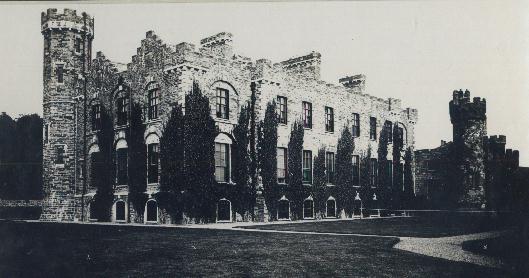
|
| Balteenbrack | Rev. Patrick Sheehy was leasing this property from the representatives of Henry Galway at the time of Griffith's Valuation, when it was valued at £10. There is still an extant house at the site. | |
| Ballyva House | Ballyva house was being leased by James Hugh Smith-Barry to James R. Deane at the time of Griffith's Valuation when it was valued at £16. Lewis refers to it as the seat of M. Galway in 1837. A house is still extant at the site. | |
| Muckruss House | Henry B. Beamish was occupying Muckruss House at the time of Griffith's Valuation when it seems to have been jointly owned by him and Thomas Hungerford. It was valued at £14 10s at the time. In 1906 it was owned by William Beamish and valued at £12 10s. It is still extant. A later house, known as Dunmore House (W397379), appears on the 1890s 25-inch Ordnance Survey Map. There is a hotel and golf course in this area now. | |
| Dunowen | Dunowen House was being leased jointly by the Bandon and Smith-Barry estates to George Sandes at the time of Griffith's Valuation, when it was valued at £19. In 2009 it was offered for sale. |

|
| Ballyduvane House | Ballyduvane House was held in fee by Mrs. Eliza Beecher at the time of Griffith's Valuation, when it was valued at £25 10s. Lewis refers to it as the seat of M. Becher in 1837. There is still an extant house at the site. | |
| Ballyduvane | Edward Herrick was leasing this property from Mrs. Eliza Beecher at the time of Griffith's Valuation, when it was valued at £12 5s. Lewis refers to it as the seat of E, Herrick in 1837. In 1814 Leet noted it as the residence of Thomas Herrick. Referred to by Slater as the seat of M.A.R. Beecher in 1894. There is still a house at the site. | |
| Springmount or Carhoo House | At the time of Griffith's Valuation, William Beamish was leasing this property from the Earl of Bandon's estate, when it was valued at £11 10s. On the 25-inch map, published in the 1890s, it is labelled Carhoo House. A house and farm buildings are still extant at the site. | |
| Ballyvackey House | Ballyvackey House was held in fee by Mrs. Ellen Alleyn at the time of Griffith's Valuation, when it was valued at £11. In the late 1770s and 1780s it was occupied by the Allen family. It is not shown on the 25-inch Ordnance Survey map of the 1890 and is no longer extant. | |
| Camus House | George Hungerford was leasing Camus House from the Smith-Barry estate at the time of Griffith's Valuation, when it was valued at £19. It does not appear on the 6-inch Ordnance Survey map but is labelled Camus House on the 25-inch map of the 1890s. There is still a house at this site. | |
| Sunmount | George Beamish was leasing Sunmount to Rev. W. John Day at the time of Griffith's Valuation, when it was valued at £20 5s. Lewis refers to Ballyvackey as the seat of G. Beamish in 1837. In 1906 it was owned by William Hungerford and valued at £23. It is no longer extant. | |
| Greenfield House | The representatives of Henry Galway were leasing this property from Mrs. Honoria O'Hea at the time of Griffith's Valuation, when it was valued at £20. Lewis refers to it as the seat of Henry Galway in 1837. He also refers to "Green Park" in the parish of Creagh as the seat of John Gallway. In 1894 Slater refers to the house as the seat of Denis McCarthy Gallway. Greenfield House is no longer extant. | |
| Rathbarry Vicarage/Rectory | Lady Carbery was leasing Rathbarry Vicarage to Rev. H. Stewart at the time of Griffith's Valuation, when it was valued at £20. Labelled as Rectory on the later 25-inch Ordnance Survey map, it is now known as Rathbarry House. |

|
| Kilkeran House | Kilkeran House was leased by Charles B. Baldwin to Anne Galway at the time of Griffith's Valuation, when it was valued at £16. Lewis refers to it as the seat of M. Galway in 1837. In 1814 Leet refers to it as the seat of Charles Connell. In the 1870s it was the residence of William Woods. A house still exists at this site. | |
| Ring Arundal | Jasper Lucas was leasing a house and extensive mill complex from the Smith-Barry estate at the time of Griffith's Valuation, when its combined value was £23. The mill is not present on the 25-inch Ordnance Survey map of the 1890s. The house is still extant. |

|
| Lackenduff House | Thomas Lucas was the owner of this property, unoccupied at the time of Griffith's Valuation, when it was valued at £15 10s. Lewis refers to Lackenduff House as the seat of J. Lucas in 1837. It is still extant and occupied. |
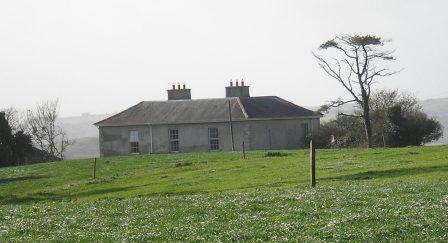
|
| Ring House | Ring House was being leased by Henry Austin to Henry B. Beamish at the time of Griffith's Valuation, when it was valued at £8 10s. There is still a house at the site. |

|
| Coppinger's Court | Built by Sir Walter Coppinger in the early seventeenth century and partially destroyed in the 1641 Rebellion. Described by Bence-Jones as an impressive semi-fortified house. By the mid nineteenth century it had fallen into ruin and is not mentioned in Griffith's Valuation, when the lessor of the surrounding land was Lady Carbery's estate. |
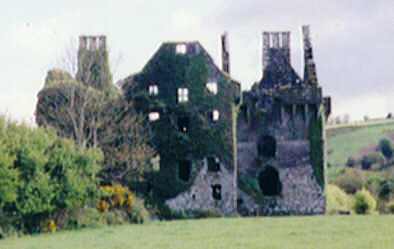
|
| Drombeg House | Drombeg was being leased by Catherine Jones from Lady Carbery's estate at the time of Griffith's Valuation, when it was valued at over £20. The sale notice of April 1852 includes a small lithograph of the house. In 1837 Lewis referred to Drombeg as the seat of Rev.Jonas Travers Jones. Leet refers to it in 1814 as the residence of John Baldwin. The house is still extant and occuped. See the Clonakilty Museum material at www.allaboutireland.ie |

|
| Bennetts Grove | Leased by Francis Bennett to William Beazley at the time of Griffith's Valuation, when it was valued at £13 10s. Lewis refers to it as the seat of Herbert Gillman in 1837. In 1814 it was the seat of Francis Bennett. The original house seems to have been replaced by farm buildings. | |
| Caherconway House | Leased by Nicholas Cummins to Daniel Bechinor [or Buchinor] at the time of Griffith's Valuation, when it was valued at almost £8. | |
| Millfield House (Ross) | This house, with a mill valued at £40, was leased by William Limerick to Henry Morrow in 1851, when the house was valued at £12 5s. Lewis notes Millfield as the seat of Lieut. Lloyd, RN, in 1837 while it is noted by Leet as the residence of Roger Sweeny in 1814. The mill is labelled Ross Mill on the 25-inch map of the 1890s. There is still an extant house at the site as well as the remains of some mill buildings. | |
| Cahermore House | In 1851 Thomas Hungerford was leasing Cahermore House from the Bishop of Cork's estate,when it was valued at £32. It was owned by Henry Hungerford in 1906 and valued at over £44. Taylor and Skinner's map of 1783 as well as Wilson in 1786 also mention Cahermore as a Hungerford residence. In 1944 the Irish Tourist Association Survey noted that Cahermore had been burnt during the War of Independence and was then derelict. Donnelly indicates that it was burnt in June 1921. It is no longer extant. | |
| Burgatia House | Leased by Robert Starkey from the estate of the Bishop of Cork at the time of Griffith's Valuation when it was valued at £12. Donnelly indicates that this house was occupied by Thomas Kingston when it was burnt in February 1921 during the War of Independence. It is no longer extant. | |
| Easton House | In 1851 Jane Smyth was leasing this property from the Bishop of Cork's estate when it was valued at £13 15s. | |
| Milleen | Rev.William Jennings was leasing this property from the Hungerford estate at the time of Griffith's Valuation, when it was valued at £19 15s. In 1944 the Irish Tourist Association Survey lists Milleen among the houses in the area which had been burnt during the War of Independence and were then derelict. It is no longer extant. | |
| Creggane House | Creggane House was in the possession of John [Lichfield] at the time of Griffith's Valuation when it was valued at almost £9. It was leased to Robert Starkey at the time. A more substantial house is shown on the later 25-inch map of the 1890s. In 1885 Walford described Francis Evans Bennett as of "Creggane". A house is still extant at the site. | |
| Derry House (Ross) | Family records indicate the original house at Derry was bought by Bryan Townsend, son of Richard, the Cromwellian officer, in the 1680s. This house was a short distance from the current house which was built by Reverend Horatio Townsend in the early years of the nineteenth century and was held in fee by Reverend Chambre Townsend in 1851 when it was valued at £44. Earlier, in 1786, Wilson referred to Derry as a Townsend seat. It was substantially damaged when it was burnt in April 1921 during the War of Independence. . At the time it was the residence of Alexander Sullivan, a well-known barrister. In 1944 the Irish Tourist Association Survey noted that it was still derelict following the 1921 burning. The centre portion of the house and a substantial farm still exist at the site. |

|
| Roury House | Occupied by William Bleazby at the time of Griffith's Valuation on lease from the Townsend estate and valued at £12 5s. In 1885 Walford refers to the seat of William J. Bleazby as Bleazby Hall. A house still exists at this site. | |
| Castle Downeen | James Courcey was leasing Castle Downeen from Rev. John Smyth in 1851 when it was valued at £23 10s. Lewis refers to the house as the seat of R. Smith in 1837. Shown as a Smith residence on Taylor and Skinner's 1783 map. In 1944 the Irish Tourist Association Survey refers to "Duneen" as "now a farmer's dwelling". It is now a ruin. | |
| Ross Abbey House (Rosscarbery) | Rev. John Hamilton was leasing this property from Elizabeth Jago at the time of Griffith's Valuation, when it was valued at £12. This house no longer exists. | |
| Cashel House (Kilmacabea) | William Wolfe was leasing this property, then valued at £12, from Miss Wheeler, at the time of Griffith's Valuation. Local records suggest the family were associated with this house since the eighteenth century. The original house is no longer extant and a modern house exists at the site now. | |
| Connonagh House | John Morris was leasing this property to Barbara Jago in 1852 when it was valued at almost £8. There is still an extant house at the site. |
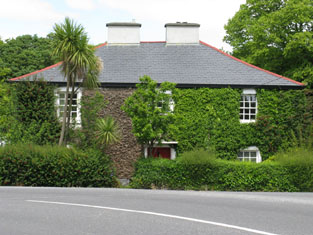
|
| Westwood/Benduff Cottage | Catherine French held this property from William Morris at the time of Griffith's Valuation. On the 25-inch Ordnance Survey map of the 1890s it is labelled Westwood. In 1906 it was owned by Michael French and valued at £13 10s. There is still an extant house at the site. | |
| Castle Salem | This property had formerly belonged to the McCarthys but was acquired by William Morris and re-named Castle Salem. In 1786 Wilson refers to it as the seat of the Morris family but by the publication of the first Ordnance Survey Map it is labelled "Benduff Castle or Castle Salem, in ruins". This property, developed over several centuries, is still extant and occupied. |
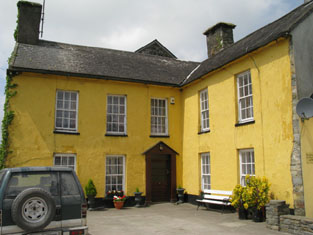
|
| Ballynagornagh House | In 1786 Wilson refers to "O'Barley-Hill" as a seat of Mr. Morris. At the time of the publication of the 1st Ordnance Survey the original Ballynagornagh House is described as "in ruins". However, a house has been restored on the site by the 1890s when it appears on the 25-inch Map. At the time of Griffith's Valuation, the townland was still in the possession of the Morris family though much of it was leased to the Donovans. The house was valued at £4 5s. A substantial farm occupies the site now. | |
| Cellmount House | Wilson, writing in 1786, refers to "Selmount House" as a seat of Mr. Morris, three miles from Ross Carbery. This property is labelled "Cellmount House, in ruins" on the 1st edition Ordnance Survey map and there is no trace of it on later maps. |

